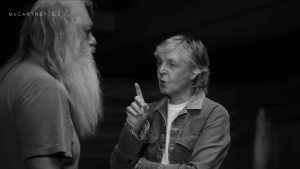In 2018, I wrote a piece bemoaning that whenever Paul McCartney is interviewed, he’s asked the same old questions and ends up offering up the same old answers he’s recited for more than 50 years. At the time, I came up with ten questions I’d ask Sir Paul if ever given the chance (which is not going to happen, I know).
That essay was going through my head while watching the new Hulu six-part series, “McCartney 3,2,1,” in which the Beatles legend talks with famed music producer and former label president Rick Rubin. Though they tread some of the same ground as so many previous interviews with McCartney, what makes the series different is when the two of them stand in front of a mixing console and go through some of the tracks of Paul’s most famous recordings.
One thing Rubin does repeatedly is isolate McCartney’s bass work, which, frankly, I’d never noticed to this extent. Hearing it amplified and explained opened up a new dimension to my appreciation of him as a musician. It wasn’t until watching this documentary that I learned there’s no tuba in “Maxwell’s Silver Hammer” — it’s an effect McCartney pulled off on his bass! Rubin asks him how, since he started out playing guitar, he ended up being the bass player in The Beatles, and McCartney offers the simplest response: “John and George said they didn’t want to do it, so I picked it up.”
Along the way, McCartney explains how, as teenagers, he and George wrote a cute little ditty based on the slogan for a furniture store in Liverpool, what inspired the lyrics to “Michelle,” and how he convinced the piccolo trumpet player on “Penny Lane” to hit a note so high it haunted him for the rest of his life.
Among the other interesting points touched on in the conversation: how stage fright kept McCartney from being a lead guitarist, the brilliant guiding influence of George Martin, and why they left some mistakes in rather than recording extra takes. He also tells some really good stories about opening for Little Richard and Roy Orbison, the influence of the Everly Brothers on The Beatles’ harmonies, and his shock at seeing Jimi Hendrix perform the opening song from “Sgt. Pepper” just two days after the album was released.
Director Zachary Heinzerling intersperses great historical footage with the stories and music lessons, which remind me of Scott Freiman’s “Deconstructing The Beatles” lecture series. But he also does something which I’ve written about hating before — shining lights directly at the camera and having bright backgrounds that make the two men in the foreground look like silhouettes. It happens often when the cameras are moving — which they need not be — while someone’s talking, and in that motion, one of the key lights is shining right into the lens. It’s not only annoying, it also causes eye strain for viewers when used too often, as it is in “McCartney 3,2,1.”
But apart from that complaint, I really enjoyed binge-watching the 6 thirty-minute episodes that make up this documentary. If you’re as avid a Beatles fan as my wife and daughter and I are, you’ll get a kick out of it, too.
I give “McCartney 3,2,1” a 9 out of 10. Streaming now on Hulu.

